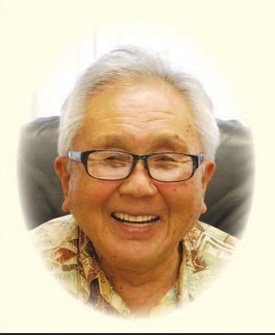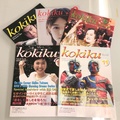Like many other fans of KIKU-TV, I binge-watched Japanese-language television shows last month knowing that the station’s multi-cultural programming was coming to an end on June 28. It was like knowing a favorite restaurant was going to be shutting down for good and wanting to sample as many of its delicacies as I could before they are no longer available.
As mentioned in last month’s issue of The Hawai‘i Herald, KIKU-TV has had a long, sometimes tumultuous history in Hawai‘i Japanese-language programming. Although I have studied the history of ethnic media in Hawai‘i and other parts of the country and am familiar with the many difficulties in sustaining these operations, the announcement that KIKU-TV would be ending its Filipino and Japanese television shows still came as a surprise. It also provided an opportunity to reflect on the many people who have worked tirelessly to use media as a way to keep Japanese Americans, and Japanese immigrants in the United States, connected with their cultural heritage.
To KIKU-TV and all individuals and businesses that have given us Japanese-language media throughout Hawai‘i’s history, we express a heartfelt and deep kansha (gratitude) for nurturing these cultural assets for as long as they were able. KIKU-TV owed its identity of many decades to the people working in the Hawai‘i broadcast industry who believed in the value of offering Japanese-language programming to the community. At any time, the station’s owners — and KIKU had changed hands a number of times — could have decided to take KIKU in different directions. And they did, but the station was always able to pivot, returning to its roots as a provider of ethnic programming, again thanks to those willing to do the hard work behind the scenes.
A Brief History of Japanese-Language Media in Hawai‘i
“Locally grown” Japanese-language media in Hawai‘i have had a fascinating, admirable history. Japanese-language newspapers, for example, began appearing in the islands not long after Japanese immigrants themselves arrived in large numbers as plantation laborers in the late 1800s. These scrappy publications had a DIY (“Do-It-Yourself”) quality to them as a labor of love produced by Issei journalists who wanted to provide news and entertainment of interest to the local Japanese community, information that mainstream English-language publications were not interested in covering.
The earliest newspapers looked crude by today’s standards, seemingly handwritten and then mimeographed, but they served an important purpose and resulted from passionate, hardworking individuals committed to the newspaper business and the Japanese community.
Japanese immigrants of that era may not have had a lot of money working on the plantations and in other jobs, but they did have tremendous literacy in the Japanese language. This was thanks to strong national educational-access laws in Japan during the Meiji and Taishō periods, which benefited even the poorest citizens. So the majority of Japanese immigrants could read Japanese when they arrived in the islands. What they had needed, however, was something to read locally.
Pioneering Japanese newspapermen filled that need. In “A Pictorial History of the Japanese in Hawai‘i, 1885-1924,” authors Franklin Odo and Kazuko Sinoto open their chapter on Japanese Language Newspapers with this aphorism: “According to a popular Japanese saying, if there are as many as three Japanese living in the same place, a Japanese newspaper is published!” Odo and Sinoto trace the first Japanese-language newspaper in Hawai‘i to 1892, with many — literally dozens — following thereafter, although with varying lifespans. It’s a long list with names like Nippon Shuhö, Hawaii Shimbun, Hawaii Shimpö, Nippu Jiji (aka The Hawaii Times), Yamato, Kona Hankyö, Hawaii Mainichi, and so forth.
These publications became an important communication network for Issei residents of Hawai‘i, keeping readers abreast of relevant current events both in their new home and their ancestral country, as well as in the rest of the world.
“For the immigrants who faced continual challenges to their struggle to improve their lives, the newspapers were critical sources of information,” Odo and Sinoto write. “Every important political issue was treated in considerable detail, from voting rights and labor movements to the language school controversy of the 1920s. Japanese-language papers could play these roles because the need for information and action was so great, and because there was a large pool of literate immigrants who could benefit from the publications.”
Even remote plantation villages in West Hawai‘i on the Big Island had access to a Japanese-language newspaper, namely the Kona Hankyö (Kona Echo), edited by Dr. Harvey Saburo Hayashi. Hayashi, a physician and Japanese immigrant himself, published the newspaper from 1897 to 1941 in addition to providing medical care to Japanese laborers on the plantations.
The Herald’s sister publication, the Hawaii Hochi, was founded in 1912 by Fred Kinzaburo Makino and played an important role in keeping the Japanese community informed about the most significant issues of the day, at times mobilizing members of the Japanese community behind demonstrations demanding civil rights and fair-labor practices.
Together with its predecessor and sometime rival Nihongo newspaper, the Nippu Jiji (later The Hawaii Times) — edited and owned by Yasutaro Soga — the Hochi helped issei agricultural workers think about labor struggles for economic justice and issues of assimilation versus cultural pluralism. These issues also transpired in Japanese-language school debates, and other pressing community challenges [see "Hawaii Hochi" and "Nippu Jiji" on Densho's Encylcopedia.
The Hochi is the only Japanese-language publication from this time period to survive today, thanks in large part to the tireless efforts of the late Paul Yempuku to extend its readership through the late 20th and early 21st centuries, who passed away on May 20, 2019.
Yempuku was committed to seeing the Hochi through good times and bad, agonizing at times over how to deal with financial struggles that just about any publisher of a Japanese-language newspaper in the United States had had to face at one time or another. When Yempuku had the honor to meet and briefly speak with Emperor Akihito and Empress Michiko (now both retired) at Kapi‘olani Park in 2009, he reportedly promised the royal couple that he would work hard to keep the Hochi publishing at least to its 100th anniversary, a promise that he was able to live to see, keeping it in 2012. The Hawaii Hochi’s printing and publishing business continues to operate under current president and publisher Taro Yoshida.
Other Japanese-language media have not been as fortunate. I have a folder filled with articles about the demise of ethnic media, especially as the Japanese-speaking and Japanese-reading population continues to shrink in Hawai‘i and on the U.S. mainland. In 2009, the Nichi Bei Times company, which served the Japanese community of northern California through several print publications including its flagship bilingual Japanese-language / English-language paper, announced that it was closing. In a letter to readers from the organization’s Board of Directors at the time, the sad news was conveyed and explained.
“This decision was not taken lightly,” the letter from the Board said. “Many hours of consideration and discussion were involved in this decision. Since 1990 the Nichi Bei Times experienced a steady decline in circulation and declining advertising revenue. Over the recent years, alternative plans of action were considered to gain new subscriptions and advertisers. Community service has been the primary consideration of the Nichi Bei Times. We felt the traditional bilingual daily did not serve today’s Japanese American community,” the letter said.
That was not the end of the story, however. A group of community members and Nichi Bei Times staff members sprang into action to form the non-profit Nichi Bei Foundation, which in turn would attempt to maintain a channel of communication with the Japanese American and larger pan-Asian communities on the Internet. Today web users can visit nichibei.org to browse through a “community-news hub” designed “to keep the community connected, informed and empowered.”
But the Nichi Bei Times’ “struggles” are really indicative of the industry as a whole. Community-based media organizations have relied heavily on advertising revenues, revenues directly affected by circulation figures which are said to reflect audience size. It is not easy to keep ethnic media in business unless there is a large enough market for them; however, as immigrant groups assimilate into the cultural fabric of the United States, they tend to seek mainstream media for information, rather than ethnic platforms. Japanese-language media also undergo such struggles to remain financially viable as the media environment itself, and its sophisticated technological audiences, have evolved over recent decades towards digital formats.
Even if the so-called target audience for a media product is growing or stable in size, that doesn’t mean members of that particular group will gravitate to the media product as hoped for and intended by the media company. For example, some cable television entities started the International Channel, later rebranded as AZN Television (made to sound like “Asian” Television), aimed at young English-speaking Asian Americans in the 1990s. Comcast Corporation decided to shut down the network in the summer of 2008, citing financial reasons, even though Asian Americans represented a fast-growing segment of the population with increasing purchasing power. A number of magazines targeting this same demographic group also have come and gone. What has kept some publications afloat is the presence of alternative revenue streams, such as printing, translation or production services offered by the parent company and which subsidize the ethnic-media product.
Back in Hawai‘i, Japanese-language media and programming have been disappearing gradually over the decades, but there was a time when such programming was popular and drew large enough audiences to not only keep them viable but also vibrant. Japanese-language radio programs, for example, were in existence in Hawai‘i as far back as the 1920s. And in the early days of television in Hawai‘i, there were Japanese cultural programs, like variety shows, on commercial-television stations like KGMB. They featured traditional music, singing and dance as well as talk story or conversation time.
Commercial radio stations like KGU, KGMB and KIKI featured Japanese-language programs. From 1947 to 1952, seven different English-language radio stations had formed Japanese-language programming departments. These programs shared airtime with English-language programs during different times of the day. But this was an era when the Japanese-speaking population was still large in Hawai‘i. Radio listeners did not have to be able to read and write Japanese, just understand it. This might have appealed to listeners whose literacy in the Japanese language was limited (e.g., Hawai‘i-born nisei who understood spoken Japanese from their parents but who were educated primarily in the English language).
Hawai‘i’s social environment was different then than it is today. This was an era when you had physical venues like the Toyo Theater, Toho Theater, Kokusai Theater and Nippon Theater regularly showing Japanese-language films to local audiences on a regular basis. Samurai movies, yakuza (gangster) films and dramas, even comedies, were popular with Hawai‘i residents, including the younger generation and their non-Japanese friends who did not speak Japanese and had to rely on subtitles. Neighborhood movie theaters also showed movies made in Japan, and audiences back then were familiar with famous Japanese movie stars who regularly appeared in films shown at these theaters and whose names moviegoers would instantly recognize, like Kinnosuke Nakamura, Hashizö Ökawa, Satomi Kötarö, Katsu Shintarö, Raizö Ichikawa and others.
Japanese-language media and culture in general were suppressed during World War II due to government concerns over enemy espionage, but they enjoyed a resurgence after the war ended. The community’s experience with World War II punctuated the fact that operating Japanese-language institutions in Hawai‘i was not only hard work but also risky business.
Japanese-language newspapermen and schoolteachers were among those rounded up by the United States government and imprisoned as so-called “enemy aliens” in Hawai‘i and in government internment camps on the U.S. mainland. Author Gail Okawa excavates the personal stories of a number of these individuals, including her own grandfather, in a book called, “Remember Our Grandfathers’ Exile: US Imprisonment of Hawai‘i’s Japanese in World War II” (University of Hawai‘i Press, 2020) which was reviewed in the Herald’s July 2, issue by author and film producer Tom Coffman.
Today the movie environment is dramatically different in Hawai‘i. Japanese movies are not regularly shown in theaters throughout the state. In fact, many such theaters mentioned above no longer exist, demolished or repurposed over the decades to pave the way for modern land development projects and shopping areas. Occasionally a foreign film, that appeals to international audiences and that happens to be made in Japan, will find its way into Hawai‘i theaters. More frequently, the Hawai‘i International Film Festival includes a healthy portion of contemporary and period Japanese-language films each year as part of its cinematic banquet. But the theatrical format of movie exhibition, which brings ethnic communities together in their local neighborhoods, is also dying out, as device- or home-viewing (streaming) become the standard.
* This article was originally published in the Hawaii Hearald on July 16, 2021.
© 2021 Kevin Y. Kawamoto






